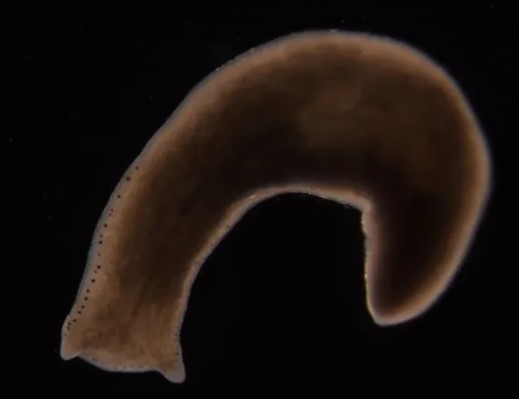Flatworms, belonging to the Phylum Platyhelminthes, encompass a vast range of organisms, from free-living species to notorious parasites. Among these, planarians and tapeworms stand out due to their unique lifestyles and physiological characteristics. While both share a common ancestry that paints them with a broad evolutionary brush, their divergent paths have led them to occupy very different niches in the natural world.
Planarians are non-parasitic flatworms known for their remarkable regeneration capabilities, thriving in both freshwater and marine environments. Tapeworms, on the other hand, are parasitic, residing within the intestines of vertebrates, including humans, where they can cause significant health issues. The primary difference between planarians and tapeworms lies in their habitat, lifestyle, and impact on their surrounding environment and hosts.
Planarians, with their darting movements and eye-spots, are often considered intriguing subjects of scientific study, particularly in the fields of regeneration and stem cell research. Tapeworms, recognized for their elongated bodies divided into segments, evoke concern due to their parasitic nature, affecting millions globally. Understanding the distinct biological and ecological roles of these creatures provides insight into the complexity of life and the delicate balance within ecosystems.
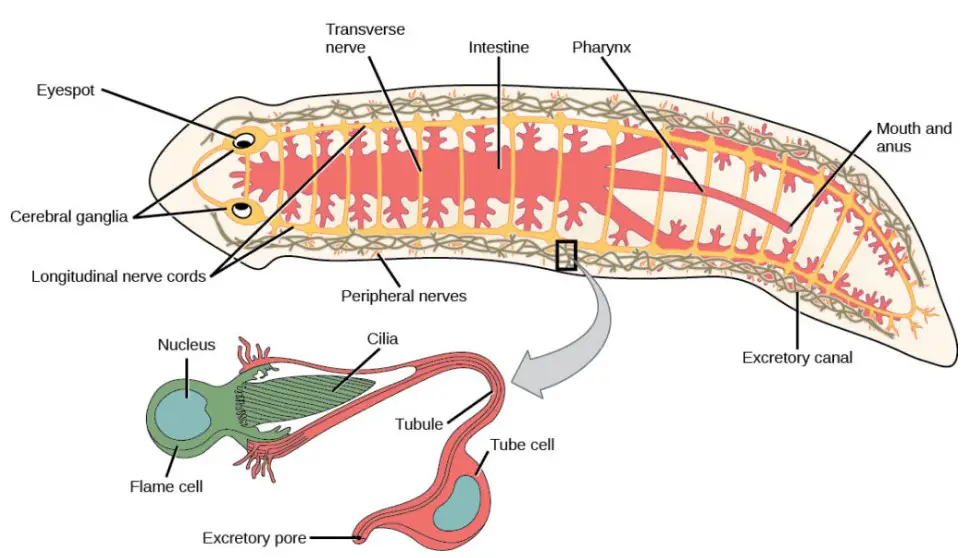
Flatworm Basics
Taxonomy and Classification
The animal kingdom is home to a diverse group of organisms known as flatworms, classified under the phylum Platyhelminthes. This phylum encompasses a wide range of creatures, from harmless, free-living species found in moist environments to dangerous parasites residing within the bodies of other animals.
Platyhelminthes are bilaterally symmetrical, a trait indicating their evolutionary advancement. They are devoid of a body cavity, a characteristic termed as acoelomate. This phylum is further divided into several classes, with Turbellaria, Cestoda, and Trematoda being the most notable. Turbellaria includes mostly free-living flatworms like planarians, while Cestoda and Trematoda consist of parasitic species, including tapeworms and flukes, respectively.
Anatomy and Physiology
General Flatworm Body Plan
The typical flatworm body is soft, flattened dorsoventrally, and covered in ciliated epithelium, which facilitates movement. They possess a head and tail region, although the body is not segmented. Internally, flatworms showcase a simple but effective digestive system, with a mouth and gastrovascular cavity that serves both digestive and distributive functions, due to the absence of a circulatory system.
Comparison of Planarian and Tapeworm Structures
Planarians and tapeworms differ markedly in their physical structures, reflecting their lifestyles. Planarians have a distinct head with eye spots (ocelli) that detect light and lateral flaps (auricles) that sense chemicals, aiding in navigation and prey detection. Their bodies can regenerate completely from significant injuries, showcasing their remarkable regenerative abilities.
Tapeworms, conversely, lack a digestive system, absorbing nutrients directly through their skin from the host’s intestine. Their bodies are elongated, segmented (proglottids), and have a specialized head region (scolex) equipped with hooks and suckers for attachment to the intestinal wall of their hosts.
Planarians Explored
Habitat and Lifestyle
Natural Environments
Planarians thrive in various freshwater and marine environments, preferring shaded or covered areas like under rocks and leaves. They are also found in moist terrestrial habitats, illustrating their adaptability.
Feeding Habits and Prey
Planarians are carnivorous, feeding on small aquatic animals and dead organic matter. They hunt using their keen sense of smell and sight, engulfing prey through their extendable pharynx.
Reproduction and Growth
Asexual and Sexual Reproduction
Planarians display both asexual and sexual reproduction methods. Asexually, they can reproduce through regeneration, where a single individual splits and regenerates into two complete organisms. Sexually, they engage in cross-fertilization, exchanging sperm with another planarian due to their hermaphroditic nature.
Regeneration Capabilities
One of the most fascinating aspects of planarians is their regeneration capabilities. They can regenerate any part of their body, including their brain, making them a subject of extensive research in regenerative medicine and biology.
Tapeworms Uncovered
Parasitic Nature
Lifecycle and Hosts
Tapeworms have a complex lifecycle, involving multiple hosts. The primary host, usually a vertebrate where tapeworms reach maturity and reproduce, and intermediate hosts, typically invertebrates or smaller vertebrates, where larval stages develop. This lifecycle allows them to spread and increase their chances of survival.
Human and Animal Impact
Tapeworms can cause various diseases in humans and animals, such as taeniasis and cysticercosis, leading to nutritional deficiencies, intestinal blockages, and in severe cases, neurological issues.
Detection and Treatment
Symptoms of Tapeworm Infections
Symptoms can range from mild to severe, including abdominal pain, weight loss, and malnutrition. In some cases, especially in cysticercosis, neurological symptoms may arise if the larval stages invade the central nervous system.
Modern Treatment Methods
Treatment typically involves antiparasitic medications that kill the tapeworms. Preventive measures include cooking meat thoroughly, practicing good hygiene, and regular deworming of pets, which are crucial steps to prevent infection.
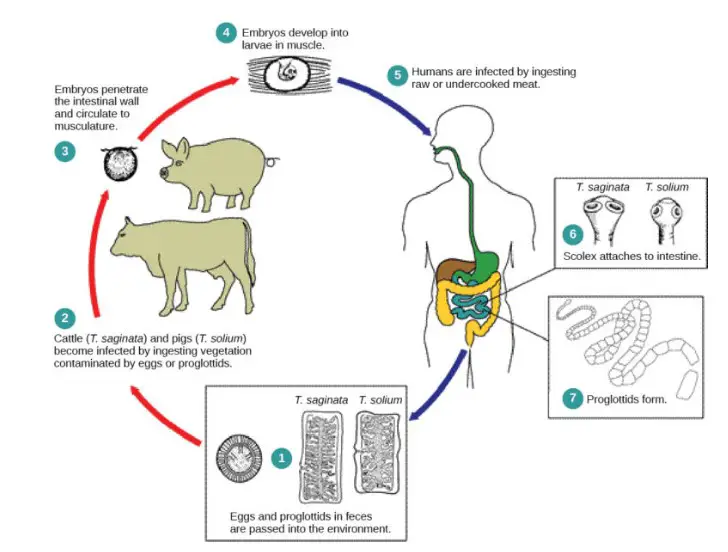
Key Differences Highlighted
Physical Distinctions
Body Shape and Size
The most obvious difference between planarians and tapeworms lies in their body shape and size. Planarians typically have a triangular-shaped head and a tapered body, allowing them to navigate through water or moist environments easily. They are relatively small, usually measuring a few millimeters to a couple of centimeters in length.
Tapeworms, in contrast, are long and flat, resembling a ribbon. Their bodies are made up of segments, known as proglottids, which can stretch to several meters in length in some species. This elongated body helps them to anchor to the host’s intestinal walls securely.
Internal and External Anatomy Comparison
Internally, planarians possess a simple centralized nervous system, a gastrovascular cavity for digestion, and eyespots that sense changes in light. These features support their free-living lifestyle, enabling them to hunt for prey and navigate their environment.
Tapeworms lack a digestive system, as they absorb nutrients directly through their skin from the host’s intestine. Their head, or scolex, is equipped with hooks and suckers for attachment to the host, a feature that is critical for their parasitic lifestyle.
Ecological Roles
Environmental Impact of Planarians
Planarians play a significant role in aquatic and moist terrestrial ecosystems as predators of small organisms and as prey for larger species. Their presence indicates a healthy environment, as they are sensitive to pollution and habitat destruction.
Health Implications of Tapeworms
Tapeworms, being parasites, have a substantial negative impact on their hosts, including humans and animals. They can cause nutritional deficiencies, intestinal blockages, and, in severe cases, neurological issues if larval stages migrate to the brain.
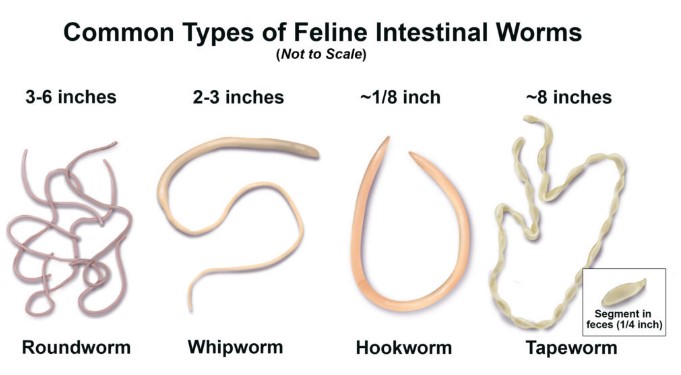
Control and Prevention
Managing Planarian Populations
Impact on Ecosystems
While planarians are generally not harmful, in some cases, they can become invasive and disrupt local ecosystems, particularly when introduced into new environments. Their predatory nature can reduce the populations of native species, altering the ecological balance.
Control Measures in Aquatic Environments
To manage planarian populations in aquatic environments:
- Monitor water quality to ensure it does not favor the overgrowth of planarian populations.
- Avoid overfeeding aquatic pets to reduce excess food that could support planarian populations.
- Use physical barriers or filtration systems to control their spread in aquariums and ponds.
Preventing Tapeworm Infections
Safety Measures in Food Preparation
To prevent tapeworm infections through food:
- Cook meat to the recommended temperatures to kill any tapeworm eggs or larvae.
- Freeze fish and meat for at least 24 hours before consumption if raw consumption is desired, as freezing can kill tapeworm eggs and larvae.
- Wash fruits and vegetables thoroughly, especially if they are to be eaten raw, to remove any contamination.
Pet Deworming and Hygiene Practices
Pets are common hosts for tapeworms, which can then be transferred to humans. To prevent this:
- Regular deworming of pets, following a veterinarian’s schedule, to keep them free of tapeworms.
- Maintain good hygiene practices, including regular washing of hands after handling pets and disposing of pet feces promptly and safely.
- Control fleas on pets, as fleas can act as intermediate hosts for certain types of tapeworms.
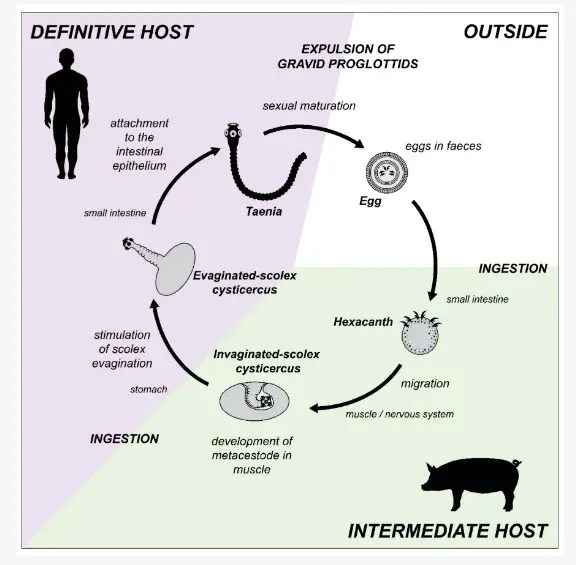
Frequently Asked Questions
How do planarians reproduce?
Planarians exhibit a fascinating mode of reproduction that can be either sexual or asexual. Asexually, they reproduce through a process known as regeneration, where a single organism can divide and grow into two separate individuals. Sexually, they are hermaphrodites, possessing both male and female reproductive organs, allowing for cross-fertilization between two individuals.
What diseases do tapeworms cause in humans?
Tapeworms are responsible for causing diseases such as taeniasis and cysticercosis. Taeniasis is the infection of the adult tapeworm in the human intestine, which can lead to digestive disturbances but is generally mild. Cysticercosis, a more serious condition, occurs when tapeworm larvae invade tissues outside the intestine, potentially leading to neurological symptoms if the central nervous system is affected.
Can planarians live outside water?
Planarians primarily inhabit aquatic environments, including freshwater and marine ecosystems. They require a moist habitat to survive and are not adapted to live outside water for extended periods. Their survival outside water is limited to short durations, depending on the humidity and temperature of their immediate environment.
How can tapeworm infections be prevented?
Preventing tapeworm infections primarily involves practicing good hygiene, proper cooking of meat, and regular veterinary care for pets. Thoroughly cooking meat to safe temperatures can kill tapeworm eggs and larvae, while washing hands and maintaining clean cooking areas can prevent accidental ingestion of tapeworm eggs.
Conclusion
In summary, planarians and tapeworms exemplify the diversity and complexity of flatworms, each playing distinct roles within their respective ecosystems. Planarians, with their regenerative abilities, offer valuable insights into biological processes, whereas tapeworms, as parasites, underscore the importance of preventive health measures and the challenges of managing parasitic infections. Understanding these differences not only enriches our knowledge of biology but also highlights the interconnectedness of life, from the simplest organisms to complex human societies.
The exploration of planarians and tapeworms bridges the gap between curiosity and scientific understanding, shedding light on the evolutionary adaptations that enable these creatures to thrive. It serves as a reminder of the vastness of life’s tapestry, woven with threads of survival, adaptation, and the ongoing quest for knowledge in the face of nature’s mysteries.

